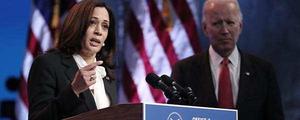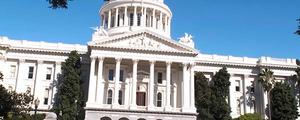Story Highlights
- Last job approval rating of 34% is his lowest
- Averages 41% job approval, four points lower than any other president
- Approval ratings of Trump most politically polarized by wide margin
WASHINGTON, D.C. -- As President Donald Trump prepares to leave the White House, 34% of Americans approve of the job he is doing as president, the worst evaluation of his presidency. His 41% average approval rating throughout his presidency is four points lower than for any of his predecessors in Gallup's polling era. Trump's ratings showed a record 81-percentage-point average gap between Republicans and Democrats -- 11 points wider than the prior record.
Trump Leaves on a Personal Low Note
The 34% job approval rating for Trump in Gallup's Jan. 4-15 poll is one point lower than his prior lowest single rating, registered on several occasions in late 2017. The first of these came in August 2017, as Trump was facing intense criticism over his unvarnished threats against North Korean aggression and his response to deadly violence by a white nationalist at a protest in Charlottesville, Virginia.
Between October and December of that year, his approval fell to 35% on three separate occasions as Justice Department officials charged several of Trump's 2016 campaign figures with crimes in the Russia investigation, including former Trump National Security Adviser Michael Flynn, who pleaded guilty to lying to officials in the investigation in December 2017.
Trump's approval high point was 49%, achieved on several occasions in early 2020 spanning the time between the Senate trial in his first impeachment and the initial stages of the coronavirus pandemic, when Americans were giving him high marks for his response to it.
His support fell below 40% in two June 2020 polls amid racial justice protests in response to the death of George Floyd at the hands of police and growing displeasure with his handling of the pandemic. By the time of the 2020 election in which he sought a second term, his support had recovered somewhat, and 46% approved of the job Trump was doing.

Line graph. Full trend on Donald Trump's job approval rating as president. Trump began his presidency with a 45% job approval rating. By the end of 2017 he registered several 35% readings. In mid-2018 that improved briefly to 45%, but was 38% at the time of the 2018 midterm elections. He registered several 49% readings in early 2020 before falling to 39% in May 2020. He ended his presidency with 34% approval.
Trump is the only president not to register a 50% job approval rating at any point in his presidency since Gallup began measuring presidential job approval in 1938. Likewise, he is the only president who did not have a honeymoon period of above-average ratings upon taking office. His initial 45% job approval rating proved to be his high point for his first year as president.
However, public support for Trump did improve modestly in each year of his presidency, averaging 38% his first year, 40% his second year, 42% his third year and 43% his last year.
But any positive momentum the president enjoyed was erased after the election. Trump's refusal to concede the election and his attempts to overturn the results, the Jan. 6 riots on Capitol Hill, a U.S. surge in coronavirus cases and deaths, and his second impeachment contributed to a postelection erosion in support for him.
The total 12-point drop in approval for Trump after the election is especially notable in that most departing presidents -- including two who were defeated for a second term -- enjoyed increases in job approval ratings between the time of the election to choose their successor and his inauguration. On average, "lame duck presidents" before Trump saw a seven-point increase in job approval. Jimmy Carter is the only other president whose approval ratings declined during the transition period.
| Years | Final pre-election approval rating |
Final approval rating as president |
Change | ||||||||||||||||||||||||||||||||||||||||||||||||||||||||||||||||||||||||||||||||||||||||||||||||
|---|---|---|---|---|---|---|---|---|---|---|---|---|---|---|---|---|---|---|---|---|---|---|---|---|---|---|---|---|---|---|---|---|---|---|---|---|---|---|---|---|---|---|---|---|---|---|---|---|---|---|---|---|---|---|---|---|---|---|---|---|---|---|---|---|---|---|---|---|---|---|---|---|---|---|---|---|---|---|---|---|---|---|---|---|---|---|---|---|---|---|---|---|---|---|---|---|---|---|---|
| % | % | pct. pts. | |||||||||||||||||||||||||||||||||||||||||||||||||||||||||||||||||||||||||||||||||||||||||||||||||
| Truman | 1952-1953 | 32 | 32 | 0 | |||||||||||||||||||||||||||||||||||||||||||||||||||||||||||||||||||||||||||||||||||||||||||||||
| Eisenhower | 1960-1961 | 58 | 59 | +1 | |||||||||||||||||||||||||||||||||||||||||||||||||||||||||||||||||||||||||||||||||||||||||||||||
| Johnson | 1968-1969 | 42 | 49 | +7 | |||||||||||||||||||||||||||||||||||||||||||||||||||||||||||||||||||||||||||||||||||||||||||||||
| Ford | 1976-1977 | 45 | 53 | +8 | |||||||||||||||||||||||||||||||||||||||||||||||||||||||||||||||||||||||||||||||||||||||||||||||
| Carter | 1980-1981 | 37 | 34 | -3 | |||||||||||||||||||||||||||||||||||||||||||||||||||||||||||||||||||||||||||||||||||||||||||||||
| Reagan | 1988-1989 | 51 | 63 | +12 | |||||||||||||||||||||||||||||||||||||||||||||||||||||||||||||||||||||||||||||||||||||||||||||||
| G.H.W. Bush | 1992-1993 | 34 | 56 | +22 | |||||||||||||||||||||||||||||||||||||||||||||||||||||||||||||||||||||||||||||||||||||||||||||||
| Clinton | 2000-2001 | 57 | 66 | +9 | |||||||||||||||||||||||||||||||||||||||||||||||||||||||||||||||||||||||||||||||||||||||||||||||
| G.W. Bush | 2008-2009 | 25 | 34 | +9 | |||||||||||||||||||||||||||||||||||||||||||||||||||||||||||||||||||||||||||||||||||||||||||||||
| Obama | 2016-2017 | 56 | 59 | +3 | |||||||||||||||||||||||||||||||||||||||||||||||||||||||||||||||||||||||||||||||||||||||||||||||
| Trump | 2020-2021 | 46 | 34 | -12 | |||||||||||||||||||||||||||||||||||||||||||||||||||||||||||||||||||||||||||||||||||||||||||||||
| Note: Kennedy (assassination) and Nixon (resignation) did not have lame-duck periods. Kennedy had a 58% job approval rating in a Nov. 8-13, 1963, poll, the last taken before he was killed on Nov. 22, 1963. Nixon had a 24% job approval rating in an Aug. 2-5, 1974, poll, the last taken before he resigned on Aug. 9, 1974. | |||||||||||||||||||||||||||||||||||||||||||||||||||||||||||||||||||||||||||||||||||||||||||||||||||
| Gallup | |||||||||||||||||||||||||||||||||||||||||||||||||||||||||||||||||||||||||||||||||||||||||||||||||||
Though many presidents left office with weak job approval ratings, Trump is the second, along with Richard Nixon, to register his personal low rating in the final measurement of his presidency. Nixon resigned his office amid the Watergate scandal.
Record-Low Average Job Approval; Most Extreme Party Polarization
Trump is departing office having averaged 41% job approval during his four years in office, lower than any other president in Gallup polling history by four points. Harry Truman and Carter had the previous lowest presidency averages. Nixon, Gerald Ford, George W. Bush and Barack Obama also averaged less than 50% approval. John Kennedy had the highest average approval rating. The average across all presidents is 53%.
| Years | Average % approve | ||||||||||||||||||||||||||||||||||||||||||||||||||||||||||||||||||||||||||||||||||||||||||||||||||
|---|---|---|---|---|---|---|---|---|---|---|---|---|---|---|---|---|---|---|---|---|---|---|---|---|---|---|---|---|---|---|---|---|---|---|---|---|---|---|---|---|---|---|---|---|---|---|---|---|---|---|---|---|---|---|---|---|---|---|---|---|---|---|---|---|---|---|---|---|---|---|---|---|---|---|---|---|---|---|---|---|---|---|---|---|---|---|---|---|---|---|---|---|---|---|---|---|---|---|---|
| Kennedy | 1961-1963 | 70.1 | |||||||||||||||||||||||||||||||||||||||||||||||||||||||||||||||||||||||||||||||||||||||||||||||||
| Eisenhower | 1953-1961 | 65.0 | |||||||||||||||||||||||||||||||||||||||||||||||||||||||||||||||||||||||||||||||||||||||||||||||||
| G.H.W. Bush | 1989-1993 | 60.9 | |||||||||||||||||||||||||||||||||||||||||||||||||||||||||||||||||||||||||||||||||||||||||||||||||
| Clinton | 1993-2001 | 55.1 | |||||||||||||||||||||||||||||||||||||||||||||||||||||||||||||||||||||||||||||||||||||||||||||||||
| Johnson | 1963-1969 | 55.1 | |||||||||||||||||||||||||||||||||||||||||||||||||||||||||||||||||||||||||||||||||||||||||||||||||
| Reagan | 1981-1989 | 52.8 | |||||||||||||||||||||||||||||||||||||||||||||||||||||||||||||||||||||||||||||||||||||||||||||||||
| G.W. Bush | 2001-2009 | 49.4 | |||||||||||||||||||||||||||||||||||||||||||||||||||||||||||||||||||||||||||||||||||||||||||||||||
| Nixon | 1969-1974 | 49.0 | |||||||||||||||||||||||||||||||||||||||||||||||||||||||||||||||||||||||||||||||||||||||||||||||||
| Obama | 2009-2017 | 47.9 | |||||||||||||||||||||||||||||||||||||||||||||||||||||||||||||||||||||||||||||||||||||||||||||||||
| Ford | 1974-1977 | 47.2 | |||||||||||||||||||||||||||||||||||||||||||||||||||||||||||||||||||||||||||||||||||||||||||||||||
| Carter | 1977-1981 | 45.5 | |||||||||||||||||||||||||||||||||||||||||||||||||||||||||||||||||||||||||||||||||||||||||||||||||
| Truman | 1945-1953 | 45.4 | |||||||||||||||||||||||||||||||||||||||||||||||||||||||||||||||||||||||||||||||||||||||||||||||||
| Trump | 2017-2021 | 41.1 | |||||||||||||||||||||||||||||||||||||||||||||||||||||||||||||||||||||||||||||||||||||||||||||||||
| Figures are the average Gallup job approval ratings for presidents throughout their time in office. | |||||||||||||||||||||||||||||||||||||||||||||||||||||||||||||||||||||||||||||||||||||||||||||||||||
| Gallup | |||||||||||||||||||||||||||||||||||||||||||||||||||||||||||||||||||||||||||||||||||||||||||||||||||
A major reason Trump's ratings were historically low is because of the extreme polarization in his approval. In the Jan. 4-15 poll, 4% of Democrats, 30% of independents and 82% of Republicans approve of Trump's performance.
Throughout his presidency, an average of 7% of Democrats approved of the job Trump was doing, while 88% of Republicans did so. The 81-point average gap in Democratic-Republican ratings of Trump exceeds the prior record for party polarization, under Obama, by 11 points. George W. Bush's ratings differed by 61 points on average between party groups, while all other presidents' party gaps were 55 points or lower. No president before Ronald Reagan had as much as a 50-point gap in partisan approval ratings.
| Party | Republicans | Independents | Democrats | Party gap | |||||||||||||||||||||||||||||||||||||||||||||||||||||||||||||||||||||||||||||||||||||||||||||||
|---|---|---|---|---|---|---|---|---|---|---|---|---|---|---|---|---|---|---|---|---|---|---|---|---|---|---|---|---|---|---|---|---|---|---|---|---|---|---|---|---|---|---|---|---|---|---|---|---|---|---|---|---|---|---|---|---|---|---|---|---|---|---|---|---|---|---|---|---|---|---|---|---|---|---|---|---|---|---|---|---|---|---|---|---|---|---|---|---|---|---|---|---|---|---|---|---|---|---|---|
| % | % | % | pct. pts. | ||||||||||||||||||||||||||||||||||||||||||||||||||||||||||||||||||||||||||||||||||||||||||||||||
| Eisenhower | Rep | 88 | 68 | 49 | 39 | ||||||||||||||||||||||||||||||||||||||||||||||||||||||||||||||||||||||||||||||||||||||||||||||
| Kennedy | Dem | 49 | 66 | 84 | 35 | ||||||||||||||||||||||||||||||||||||||||||||||||||||||||||||||||||||||||||||||||||||||||||||||
| Johnson | Dem | 44 | 53 | 71 | 27 | ||||||||||||||||||||||||||||||||||||||||||||||||||||||||||||||||||||||||||||||||||||||||||||||
| Nixon | Rep | 75 | 48 | 34 | 41 | ||||||||||||||||||||||||||||||||||||||||||||||||||||||||||||||||||||||||||||||||||||||||||||||
| Ford | Rep | 68 | 49 | 37 | 31 | ||||||||||||||||||||||||||||||||||||||||||||||||||||||||||||||||||||||||||||||||||||||||||||||
| Carter | Dem | 30 | 42 | 57 | 27 | ||||||||||||||||||||||||||||||||||||||||||||||||||||||||||||||||||||||||||||||||||||||||||||||
| Reagan | Rep | 83 | 54 | 31 | 52 | ||||||||||||||||||||||||||||||||||||||||||||||||||||||||||||||||||||||||||||||||||||||||||||||
| G.H.W. Bush | Rep | 82 | 57 | 44 | 38 | ||||||||||||||||||||||||||||||||||||||||||||||||||||||||||||||||||||||||||||||||||||||||||||||
| Clinton | Dem | 27 | 53 | 82 | 55 | ||||||||||||||||||||||||||||||||||||||||||||||||||||||||||||||||||||||||||||||||||||||||||||||
| G.W. Bush | Rep | 84 | 44 | 23 | 61 | ||||||||||||||||||||||||||||||||||||||||||||||||||||||||||||||||||||||||||||||||||||||||||||||
| Obama | Dem | 13 | 44 | 83 | 70 | ||||||||||||||||||||||||||||||||||||||||||||||||||||||||||||||||||||||||||||||||||||||||||||||
| Trump | Rep | 88 | 37 | 7 | 81 | ||||||||||||||||||||||||||||||||||||||||||||||||||||||||||||||||||||||||||||||||||||||||||||||
| Note: Gallup does not have complete party data for Truman | |||||||||||||||||||||||||||||||||||||||||||||||||||||||||||||||||||||||||||||||||||||||||||||||||||
| Gallup | |||||||||||||||||||||||||||||||||||||||||||||||||||||||||||||||||||||||||||||||||||||||||||||||||||
Trump's 7% rating among Democrats is by a significant margin the lowest for a president among supporters of the opposition party. Obama's 13% average approval among Republicans was the prior low. All other presidents before Obama had at least a 20% average rating among opposition party supporters, with Dwight Eisenhower, Kennedy, Lyndon Johnson and George H.W. Bush all above 40%.
At the same time, no president has had a higher average job approval rating during his term among his own party's supporters than Trump has. Republicans' average 88% approval of Trump ties Eisenhower's as the highest own-party approval score, though most presidents had better-than 80% approval among their fellow partisans.
Trump's last year in office also set a new standard for polarization in a single year in office, with an average 85-point gap between Republicans' (91%) and Democrats' (6%) ratings of him during his fourth year in the White House. Trump's term now includes the first-, second-, third- and seventh-most polarized years in office.
In Gallup's final survey before Election Day 2020, 92 points separated Republicans' (95%) and Democrats' (3%) approval of Trump, the most ever in a single measurement.
In addition to extreme party polarization, Trump's job approval ratings were historically low because political independents were significantly less likely to support him than any other president. Trump averaged 37% job approval among independents throughout his term, five points lower than Carter (42%) and seven points lower than George W. Bush (44%) and Obama (44%).
Bottom Line
Trump leaves office as the least-positively evaluated president in the Gallup polling era, based on the average of his approval ratings. He also just received his personal low approval rating, thanks largely to a sharp decline in public support during a lame-duck period marked by controversy, which could overshadow his accomplishments.
His final job approval rating of 34% is not the lowest among presidents, however, as that distinction goes to Harry Truman's 32% rating, while Trump is tied with Carter and George W. Bush for the second-lowest.
The significance of Trump's final rating could be more important than his average, as the former is the one that is often most predictive of how presidents are regarded historically.
Perhaps more than anything, Trump's public support will be remembered for its sharp degree of party polarization. His Republican base remained solidly behind him throughout. At no point in his presidency did less than 77% of Republicans approve of him. The low-water marks for other recent GOP presidents were significantly lower -- 67% for Reagan, 57% for George H.W. Bush and 55% for George W. Bush.
But more than any other president, Trump struggled to appeal beyond his base. That made it extremely challenging for him to win a second term, especially considering that fewer than one in three U.S. adults identify as Republicans and more independents lean to the Democratic Party than the Republican Party. As such, all of his job approval ratings were below the historical average, and none reached 50%.
Explore President Trump's approval ratings and compare them with those of past presidents in the Gallup Presidential Job Approval Center.
View complete question responses and trends (PDF download).
Learn more about how the Gallup Poll Social Series works.



